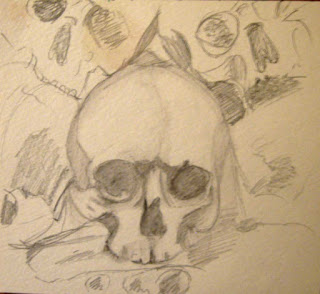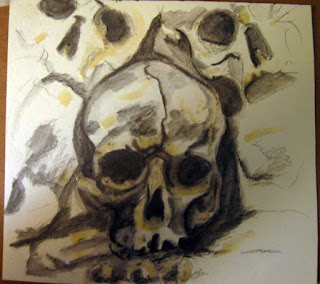Black Friday is my annual "doomsday" when I pull all of my blinds, lock the doors, and scrutinize the caller ID if the phone rings. Since it is already after 10 AM here, I figure Walmart and Best Buy are already stripped like a Thanksgiving turkey at an office potluck, but I still won't set foot in town until Monday. I plan to do some gift list posts over the next few weeks, but all of the hyperbolic "Black Friday Blowout!!!" emails have inspired me to make my own wish lists as well. It is not entirely selfish since I am sure that other artsy folks are eyeballing the same products, and I know that choosing gifts for artists can be hard for non-artistic people.
Today's List is Pure Fantasy!
I used to hate asking for anything for Christmas, but as I have gotten older I understand that giving my loved ones a "wish list" is actually helpful and appreciated. It saves them time, and they won't be worried whether or not I will like their gifts. In short, wish lists are considerate, not selfish. Let me clarify that last point to say reasonable wish lists are considerate. I would never ask for luxury items that I secretly drool over, so I thought it would be fun to feature a list of awesome art-related gifts that I would really love but could never ask anyone to buy. I should also note that these items would never show up on this blog in review posts, so this is the only way I can justify the Black Friday window
Affiliate Disclaimer: For full transparency, you should know that many of my links in my posts are affiliate links. As an Amazon affiliate, I receive a small commission when readers purchase items using my affiliate links. This helps me fund the blog domain costs, and you will not be charged extra if you buy anything using my links.
Wacom Cintiq ($800-$2800)
Even though I am an avid traditional artist, I still enjoy creating digital art. I have dabbled with graphic design and illustration in the past, so I have experience using graphic tablets and digital painting, drawing and photo editing software. I have owned a few Wacom tablets since 2004, and I tend to wear them out completely before replacing them. Currently, my daughter uses our most recent purchase- a Wacom Intuos Pen and Touch. However, Cintiq is the Holy Grail line for most digital artists.
Typical Wacom tablets act as input devices for your computer, so you are drawing on the tablet while monitoring your work on the computer screen. It takes some adjustment when you first start using one of these devices, but most people get the hang of it fairly quickly. Cintiq is very different because it is a monitor as well as a graphics tablet, so you draw directly on the screen like you would draw on paper. Wacom has now introduced the Cintiq Companion 2, which is a stand alone PC tablet with a Windows 8.1 (upgradable to Windows 10 for free) operating system as well as a high-end graphics tablet that you can plug into a desktop Mac or PC to use in the more familiar manner. Its 13.3 inch screen gives you plenty of room to express yourself as well.
The specs are listed here, so I am not going to drone on about that. Prices for the Cintiq Companion 2 range from $1300 to $2300. The classic Cintiq monitors are still a thing as well, and the newest ones are divine! The 27" model (pictured below) will set you back about $2800, while the "entry level" 13" model is a modest $800. All Cintiqs work with Windows and Mac, and you can probably get them to work with your Linux machine if you are gifted in that way.
 | |||
| The 27" Cintiq is a thing of great beauty- click on image (credit: Wacom.com) to go to the webpage | . |
H Frame Studio Easels
Since I only review products that I have actually used, I have not had the pleasure of making a post devoted to easels. I have been drooling over dozens of fantastic studio easels for months. I have a $17 folding aluminum easel that is good at one thing: pissing me off. By the time I get it set up in halfway usable configuration, I am too angry and frustrated to paint. I know that I will have to spend at least $100 if I want an acceptable easel, but the models that make my heart sing are way too pricey for my budget. Oh well, a girl can dream!
I want an H-frame because I can predict the space requirement more easily with the quad base. A-frames or tripod bases may need far more floor space than expected when used at certain angles, but the H-frame base takes up the same amount of floor space regardless of any adjustments. It is also more stable than the three-legged varieties. Jerry's Artarama has a pretty awesome selection of easels and some great Black Friday Deals that make me wish I had money. Here are a couple of my favorite H frames:
Carolina Studio Easel
This is a classic H-frame made from "oiled and seasoned wood" that can accommodate a nice range of canvas sizes. It is fully adjustable so you can work standing or seated and its maximum height is over 100", so taller artists do not have to stoop.
The usual Jerry's price is $160, but it is on sale for $119 currently.
 Eagle Rock Studio Easel
Eagle Rock Studio Easel
This is a variation on the same theme as the Carolina model, but the Eagle Rock H frame has a crank height adjustment, which means that you can change the height without getting up from your chair or removing your canvas. The tilt angle, mast head, and canvas holder are all adjustable, and this easel has casters so you can move it around with ease. Two of the casters lock so you don't have to worry about it rolling away as you work.
This lovely is available for just under $310 at Jerry's.
Fancy Watercolor Paints
I use affordable brands of paints that are rather decent quality, but if I could buy any kind of watercolors, I would probably go for the pricier professional grade brands like Sennelier and Windsor & Newton. I also have a thing for pans, but why not go whole hog and get tubes for my fantasy art studio?
Sennelier French Artist's Watercolors are highly-rated professional grade paints that come in 10 and 21 ML tubes. There are 98 colors in Sennelier's collection, but my personal color pallet would include the following 21ml tubes:
Alzarin Crimson Lake, $10.67
Cadmium red light, $13.42
Bright Red, $9.96
French Vermillion, $9.96
Opera Rose, $9.96
Rose Madder Lake, $9.96
Burnt Sienna, $8.80
Burnt Umber, $8.80
Gold Ochre, $8.80
Naples Yellow, $8.80
Quinacridone Gold, $10.67
Dioxanine Purple, $10.67
Pthalo Blue, $8.80
Cerulean Blue, $13.42
Ultramarine Deep, $9.96
Prussian Blue, $8.80
Hooker's Green, $8.80
Sennelier Green, $8.80
Sap Green, $8.80
Grand Total: $187.85
I know I harp on limiting one's color pallet to a bare minimum and mixing colors, but this is a fantasy list for which I have hypothetical money to throw around, so the not-lazy color mixing is right out the window here. These are the big tubes, so I think I could survive several years with this much paint!
I have always loved Windsor & Newton products, but even student grade items from this company are a splurge in "real life". However, I would not hesitate to consume these professional watercolors in a most conspicuous manner if I had the funds. These paints come in 5,14,and 37 ml tubes, but not all colors are available in all three sizes, so I listed the largest size for each color. Here is my fantasy W&N watercolor pallet:
Alzarin Crimson, $14.80 (37 ml)
Cadmium red, $14.65 (14 ml)
Quinacridone Red, $11.25 (14 ml)
Windsor Red, $14.80 (37 ml)
Opera Rose, $10.40 (14 ml)
Rose Madder Genuine, $23.40 (37 ml)
Burnt Sienna, $14.80 (37 ml)
Burnt Umber, $14.80 (37 ml)
Gold Ochre, $10.40 (14 ml)
Naples Yellow, $9.35 (14 ml)
Quinacridone Gold, $14.80 (37 ml)
Permanent Mauve, $11.25 (14 ml)
Windsor Blue (green), $14.80 (37 ml)
Manganese Blue Hue, $10.40 (14 ml)
French Ultramarine, $16.10 (37 ml)
Prussian Blue, $9.35 (14 ml)
Hooker's Green, $9.35 (14 ml)
Windsor Green (yellow), $14.80 (37 ml)
Permanent Sap Green, $14.80 (37 ml)
Grand Total: $254.30
Yeah, I almost fainted when I saw that bottom line too!
My next posts are going to be gift guides for artists, and I plan to break them down by medium. I know that my family members are overwhelmed when they try to buy me arts and craft items. Shopping for artists is so much easier when you have a list tailored to their favorite mediums.




















